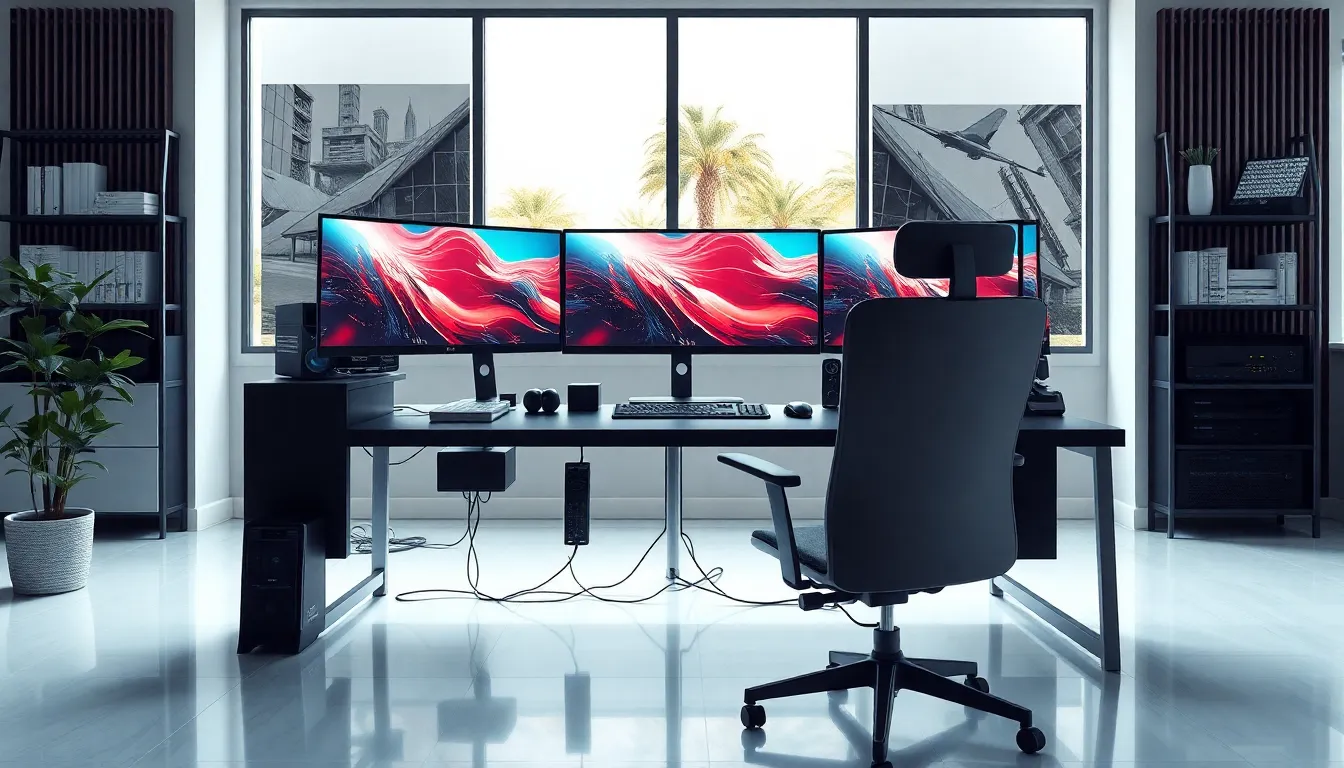Table of Contents
ToggleIn today’s fast-paced digital landscape, having the right workstation hardware is crucial for maximizing productivity and efficiency. Professionals across various fields rely on powerful machines to handle demanding tasks, from graphic design to data analysis. The right components not only enhance performance but also ensure a smoother workflow.
Choosing the perfect workstation hardware can be overwhelming with so many options available. Factors like processing power, memory capacity, and graphics capabilities play a significant role in determining the best setup for specific needs. Understanding these elements can help individuals and businesses make informed decisions that align with their goals and budget.
Overview of Workstation Hardware
Workstation hardware encompasses various essential components designed to meet the rigorous demands of professional applications. Understanding these components aids in selecting the appropriate system for specific tasks.
Key Components
- Processor: The processor serves as the core of the workstation, determining the speed and efficiency of operations. High-performance multi-core processors, such as Intel Xeon or AMD Ryzen Threadripper, deliver optimal processing power for rendering, simulations, and complex computations.
- Memory: Memory capacity affects multitasking and application responsiveness. Workstations typically utilize ECC (Error-Correcting Code) RAM to enhance stability. Configurations often range from 16GB to 128GB, depending on software requirements.
- Storage: Storage options significantly influence data access speeds. SSDs (Solid State Drives) provide faster read/write speeds than traditional HDDs (Hard Disk Drives). Workstations often include hybrid setups for improved performance and larger storage capacity.
- Graphics Card: The graphics card enhances visualization and rendering capabilities. High-end GPUs, such as NVIDIA Quadro or AMD Radeon Pro, support advanced graphics-intensive applications used in design, video editing, and scientific calculations.
- Motherboard: The motherboard connects all components and affects system scalability and upgrade options. Professional-grade motherboards support multiple GPUs and extensive memory configurations to accommodate future needs.
- Cooling Systems: Efficient cooling systems prevent overheating during intensive tasks. Workstations often feature liquid or advanced air cooling solutions to maintain optimal operating temperatures.
Form Factor Considerations
Choosing the form factor aligns with workspace requirements. Workstation designs range from compact towers to rack-mounted systems, affecting portability and expansion capability. Desktop workstations offer accessibility, while mobile workstations provide flexibility for on-the-go professionals.
Connectivity and Ports
Connectivity options enhance peripheral integration. Most workstations include USB-C, Thunderbolt, and HDMI ports to support external displays and devices. Network interfaces such as Ethernet ensure stable internet connections for online collaboration and cloud computing.
Power Supply
A reliable power supply unit (PSU) is crucial for delivering stable power to all components. High-wattage units are recommended to support power-hungry GPUs and processors, ensuring uninterrupted performance during demanding tasks.
This overview provides insight into the critical elements of workstation hardware, guiding users in making informed choices tailored to their professional requirements.
Key Components of Workstation Hardware

Key components play a crucial role in defining workstation performance and efficiency. Understanding each hardware element helps in selecting the optimal configuration for specific professional tasks.
Processors
Processors significantly influence overall system performance. High-performance models like Intel Xeon and AMD Ryzen Threadripper deliver robust computing power essential for multitasking and demanding applications. Multi-core architectures improve efficiency by allowing parallel processing of tasks. Seek processors with high clock speeds and efficient thermal management to maximize productivity.
Memory
Memory capacity directly impacts system responsiveness and application performance. ECC (Error-Correcting Code) RAM enhances stability and reliability, making it ideal for mission-critical environments. Typically, 32GB or more is recommended for intense workloads, such as 3D rendering or large-scale data analysis. Higher bandwidths provide improved data transfer rates, which are vital for robust performance in professional workflows.
Storage Solutions
Storage solutions determine data access speed and overall system agility. Solid State Drives (SSDs) offer superior data transfer rates compared to traditional Hard Disk Drives (HDDs), significantly reducing load times. For optimal performance, consider NVMe SSDs, which utilize the PCIe interface for faster data exchange. Implementing a combination of SSDs for operating systems and applications, along with larger HDDs for data storage, often balances speed with capacity.
Graphics and Display Options
Graphics and display options play a crucial role in workstation performance, particularly for tasks involving heavy rendering, graphic design, and data visualization. Professionals require powerful GPUs and high-resolution monitors to enhance their productivity and deliver precise results.
Graphics Processing Units (GPUs)
GPUs serve as vital components in graphic-heavy applications. High-end GPUs, like NVIDIA Quadro and AMD Radeon Pro, deliver superior performance, enabling seamless multitasking and accelerated rendering. These graphics processing units support multiple displays, allowing users to maximize their workspace with expansive visual setups. They also feature CUDA or OpenCL technologies for parallel processing, significantly enhancing performance in applications such as 3D modeling and video editing.
Monitors and Resolutions
Monitors impact visual clarity and overall user experience. Resolutions such as 4K (3840 x 2160 pixels) or 8K (7680 x 4320 pixels) provide exceptional detail, crucial for tasks requiring precision. Professionals benefit from larger screens or multi-monitor setups that facilitate multitasking while reducing eye strain. Additionally, IPS panels offer better color accuracy and wider viewing angles, making them ideal for designers and content creators. Considerations like refresh rates and response times also enhance the viewing experience, particularly in dynamic environments such as gaming or simulation.
Performance Factors
Understanding performance factors in workstation hardware is crucial for achieving optimal results. The scrutiny of these elements ensures equipment meets specific professional demands.
Benchmarking Workstation Hardware
Benchmarking evaluates how workstation hardware performs under various conditions. It involves running standardized tests that measure processing speed, memory efficiency, and graphics rendering capabilities. Common benchmarks include the PassMark, Cinebench, and SPECviewperf tests, which provide quantifiable data. This data helps compare different configurations and identify optimal setups for specific tasks, such as rendering, data analysis, or software development. Regular benchmarking allows users to assess hardware upgrades and ensure systems remain competitive.
Recommendations for Various Uses
When selecting workstation hardware, recommendations vary based on specific use cases.
- 3D Rendering: High-performance processors like Intel Xeon or AMD Ryzen Threadripper, along with a powerful GPU such as NVIDIA Quadro, are essential.
- Graphic Design: Opt for high-resolution displays with excellent color accuracy, utilizing CPUs with robust multi-core performance and specialized GPUs like AMD Radeon Pro.
- Video Editing: Prioritize SSD storage for quick access to large files, coupled with a high-end CPU and dedicated GPU to handle intensive video processing tasks.
- Data Analysis: Focus on abundant memory capacity using ECC RAM and efficient multi-thread CPUs to enhance calculation speeds.
Each use case demands a tailored hardware configuration, ensuring professionals maximize productivity and efficiency in their respective fields.
Future Trends in Workstation Hardware
Future workstation hardware trends focus on advanced technologies that enhance performance, efficiency, and adaptability for professionals. Several developments are shaping the landscape of workstation hardware.
- Artificial Intelligence Integration
AI capabilities increasingly integrate into workstation hardware. These systems optimize performance by predicting workload fluctuations, allocating resources effectively, and enhancing reliability for demanding applications.
- Energy Efficiency Improvements
Energy-efficient components become standard in workstation designs. Manufacturers are prioritizing lower power consumption, leading to reduced operational costs and environmentally friendly options, such as energy-star rated power supplies.
- Enhanced Graphics Processing Units
Graphics Processing Units (GPUs) are evolving rapidly. Future trends include real-time ray tracing and AI-driven rendering in GPUs, elevating visual output for graphic design, video editing, and simulation applications.
- Increased Memory Bandwidth
Memory technologies are advancing with innovations such as DDR5 and High Bandwidth Memory (HBM). These developments provide higher data transfer rates, supporting data-intensive applications efficiently.
- Scalability and Modular Designs
Modular workstations gain popularity for their scalability. Users can upgrade components, such as processors or storage, without replacing entire systems, which supports long-term investment strategies.
- Cloud Workstation Solutions
The rise of cloud computing influences workstation dynamics. Cloud-based solutions allow users to run high-performance applications remotely, minimizing dependence on physical hardware while providing flexibility and collaboration opportunities.
- Virtual Reality Ready Hardware
As virtual reality (VR) becomes mainstream in various industries, workstations designed for VR applications will feature dedicated components. These include higher frame rates and superior processing capabilities.
- Focus on High-Speed Connectivity
The emergence of faster connectivity standards, such as Thunderbolt 4 and USB4, improves data transfer speeds. Enhanced networking capabilities, like 5G technology, will support seamless communication between devices and resources.
These future trends indicate a shift towards more intelligent, adaptable, and efficient workstation solutions, aligning with the evolving demands of modern professionals in diverse fields.
Selecting the right workstation hardware is crucial for maximizing productivity and efficiency in today’s fast-paced digital landscape. With technology evolving rapidly professionals need to stay informed about the latest advancements to make optimal choices that align with their specific requirements.
Investing in high-performance components not only enhances workflow but also prepares users for future challenges. As industries continue to demand more from their systems understanding the significance of processing power memory capacity and graphics capabilities will remain essential. By prioritizing the right hardware individuals and businesses can ensure they are equipped to meet the demands of their work while remaining adaptable to emerging technologies.





